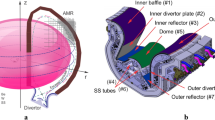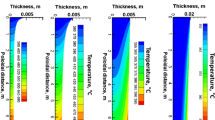Abstract
The plasma facing materials and components in existing and future fusion devices are strongly affected by plasma wall interaction processes. These components, in particular the first wall (FW), the limiters and the divertor are subject to intense quasi-stationary thermal loads during plasma operation. While the resulting thermal loads to the first wall will remain below 1 MW·m−2, special attention has to be paid to high heat flux components like limiters and the divertor. Here the expected power densities will be at least one order of magnitude above the ones at the FW, with expected peak heat fluxes of up to 20 MW·m−2 for future magnetic confinement devices. Beside quasi-stationary heat loads, short transient thermal pulses with deposited energy densities up to several tens of MJ·m−2 are another serious concern for next step tokamak devices, in particular for ITER. The most serious events are plasma disruptions, vertical displacement events, and Edge Localized Modes (so-called ELMs). These requirements make high demands on the selection of qualified materials and reliable fabrication processes for actively cooled plasma facing components. High heat flux test facilities based on intense electron and ion beams have been utilized successfully to assess the efficiency and the fatigue life time of different material solutions and design concepts. Modeling and experiments with both normal operation scenarios and transient events, are being performed to evaluate and to quantify the resulting material erosion or damage and thus to assess the life time of the components. Additional research activities are focused on the degradation of materials and joints due to energetic neutrons. In order to investigate irradiation induced property changes, materials samples and actively cooled plasma facing components have been irradiated in fission reactors and tested in thermal load tests. The technical solutions which are considered today are mainly based on beryllium, carbon materials or tungsten as armor materials and copper alloys or stainless steel for the heat sink. Furthermore, the needs for extensive quality control methods and non-destructive analyses during the procurement phase will be highlighted.
Similar content being viewed by others
References
Aymar R and International Team, J. Nucl. Mater., 307–311 (2002) 1.
Bolt H et al, J. Nucl. Mater., 307–311 (2002) 43.
Merola M, Akiba M, Barabash V and Mazul I, J. Nucl. Mater., 307–311 (2002), 1525.
Bolt H, Barabash V, Krauss W, Linke J, Neu R, Suzuki S, Yoshida N and ASDEX Upgrade team, J. Nucl. Mater., 329–333 (2004) 66.
Linke J, Lorenzetto P, Majerus P, Merola M, Pitzer D and Rödig M, in Proc ANS 16th Topical Meeting on the Technology of Fusion Energy, Madison, Wisconsin, USA (2004).
Smid I, Material Science Forum, 475–479 (2005) 1355.
Linke J M, Hirai T, Rödig M, and Singheiser L A, Fus. Sci. Tech., 46 (2004) 142.
Schlosser J, et al, Nucl. Fusion, 45 (2005) 512.
Jacquinotet J, et al, Nucl. Fusion, 43 (2003) 1583.
Hirai T, Ezato K, and Majerus P, Materials Transactions, 46 (2005) 412.
Zhitlukhin A, et al, J. Nucl. Mater., 337–339 (2005) 684.
Rödig M, Bobin-Vastra I, Cox S, Escourbiac F, Gervash A, Kapoustina A, Kuehnlein W, Kuznetsov V, Merola M, Nygren R, and Youchison D L, Fusion Engineering and Design, 75–79 (2005) 303.
Duwe R, Kühnlein W, and Münstermann H, Proc 18th Symp on Fusion Technology (SOFT), Karlsruhe, Germany (1994) p 355.
Greuner H, Böswirth B, Boscary J, Hofmann G, Mendelevitch B, Renner H, Rieck R, Fus. Eng. Design, 66–68 (2003) 447.
Merola M, Palmer J and the EU ITER Participating Team, Proc Int Symp on Fusion Nuclear Technology, Tokyo (2005).
Lorenzetto P, Boireau B, Boudot C, Bucci Ph, Furmanek A, Ioki K, Liimatainene J, Peacock A, Sherlock P, Tâhtinen S, Fusion Engineering and Design, 75–79 (2005), 291.
Federici G et al, J. Nucl. Mater., 313–316 (2003) 11.
Linke J, Amouroux S, Berthe E, Kühnlein W and Rödig M, Proc. 22nd Symp on Fusion Technology, Helsinki, (2002).
Hirai T, Linke J, Kühnlein W, Sergienko G, Brezinsek S, J. Nucl. Mater., 321 (2003) 110.
Rödig M, Kühnlein W, Linke J, Pitzer D, Merola M, Rigal E, Schedler B, and Visca E, J. Nucl. Mater., 329–333 (2004) 766.
Barabash V, Federici G, Linke J, and Wu C H, J. Nucl. Mater., 313–316 (2003) 42.
Rödig M et al, J. Nucl. Mater., 307–311 (2002) 53.
Author information
Authors and Affiliations
Corresponding author
Rights and permissions
About this article
Cite this article
Singheiser, L., Hirai, T., Linke, J. et al. Plasma-facing materials for thermo-nuclear fusion devices. Trans Indian Inst Met 62, 123–128 (2009). https://doi.org/10.1007/s12666-009-0016-y
Received:
Accepted:
Published:
Issue Date:
DOI: https://doi.org/10.1007/s12666-009-0016-y




